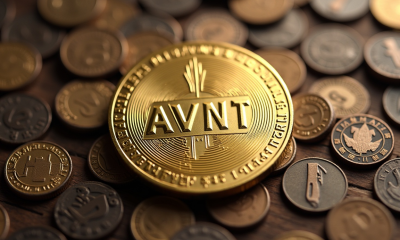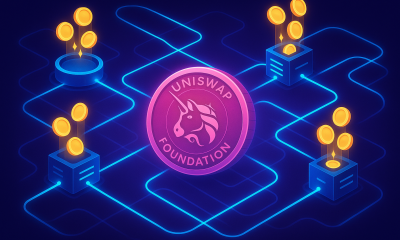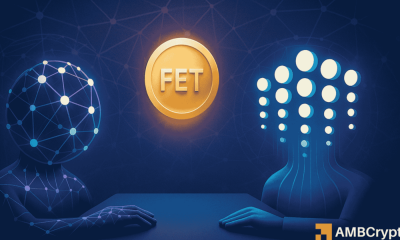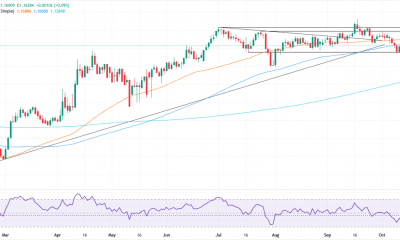

Technology
India uniquely poised to combine sprawling DPI with power of AI: Nandan Nilekani – Crypto News
New Delhi, Apr 11 (PTI) India is uniquely placed to combine its sprawling digital public infrastructure (DPI) with the power of artificial intelligence to unleash transformative use cases, Infosys chairman and Aadhaar architect Nandan Nilekani said on Friday.
Speaking at Carnegie India’s Global Technology Summit ‘Sambhavna’, Nilekani cautioned that while artificial intelligence (AI) hype cycles have reached unprecedented levels, real challenges exist in building and operationalising it at scale.
The running theme in India is how to use AI to make lives better at a low cost and at a population scale. “AI makes DPI better…The digital infrastructure we have is getting loaded with AI, and making DPI better…India will be uniquely placed because of its history, and it will combine DPI and AI to create a whole new way of doing things,” Nilekani said.
The AI playbook in India is all about focusing on individual narrow use cases, and ensuring it is safe, secure, unbiased, and responsible.
AI is not easy, certainly not an overnight “magic”, he said with a note of caution.
“There are the usual issues. How do you make the user experience seamless? What is the infrastructure we need? How do you govern these things? How do you manage the complexity? These are things we have dealt with in every field, and we are dealing with them at AI at scale,” he said.
While many of these challenges in AI are typical of new innovations in every field, the difference between previous tech advances and this one is that for the first time, AI requires trust to be placed in non-human intelligence for decision-making.
“…we didn’t do that earlier because previous technology was deterministic, predictable. Now, we are essentially expecting the machine to make decisions and there’s a huge leap of confidence, a huge leap of faith in the ability of technology to take us forward,” he said.
While people tend to be far more forgiving of human error, the same is not the case when one is dealing with a machine error. A case in point, he said, is autonomous cars, where any fatality on the road would force the provider to go back to the drawing board for two years.
Adopting AI at scale is hard work and will continue to be so, he said, adding that an even bigger challenge is the adoption of AI at scale in enterprises and public sector space.
“There’s a lot to be done if you really want to make all this AI stuff work. And all transitions are painful…This has happened before, in every industry…The difference this time…is the hype is at a different level. And people think it is some ‘pixie dust’,” he said.
Nilekani emphasised that AI adoption will not be easy.
“This is something which is much more complicated than we think,” he said. The industry veteran further observed that adoption cycles are reducing globally in general.
“Each cycle of technology takes less and less years. And in general, it has taken so much more time to get adopted in India. Interestingly, this time around, while we expect AI adoption also to take 10-15 years, our belief is that in India it can happen much faster,” he said.
The tech transformation in India would enable the country to leapfrog and narrow the gap between global developments and AI build-up here.
Pointing to the rise of India’s digital infrastructure, he said Aadhaar and UPI led to an explosion in the payments and transaction ecosystem.
As a result, the balance moved from just the global tech companies to homegrown ones backed by venture capital, Nilekani said as he cited examples of companies like Meesho, PhonePe, Physics wallah, Zepto, Rapido and others who redefined the spaces with their innovative offerings.
“India’s DPI will be the basis for using AI. So, when we look at implementing AI at scale in India, it is built on an existing foundation of digital transformation that has happened for a decade,” he said.
Going forward, the local languages, and user interface moving to voice and video (from keyboard and touch) would drive AI adoption and accessibility to a billion people.
“We believe this will lead to India becoming AI use capital of the world…DeepSeek or not, India will be the place where stuff (AI) gets used at the scale of one billion people like we have shown before with Aadhaar and UPI,” Nilekani pointed out.
Today, innovative companies are working on open-source AI models for Indian languages, reducing the cost of operation. Exorbitant prices won’t work here, he said advocating low-cost, population-scale AI.
Much of AI is about data, and its organic collection, not about building models by scraping the internet and someone else’s IP, he asserted.
The focus in India is to use AI to make lives better, not to make “things convenient”.
“It is not how do we use AI to make things so convenient that you lose your skills. It is not about dumbing down people, it is about using AI to improve the capacity and potential of human beings,” he said.
-
Cryptocurrency1 week ago
XRP News: Ripple Unveils ‘Ripple Prime’ After Closing $1.25B Hidden Road Deal – Crypto News
-

 Blockchain1 week ago
Blockchain1 week agoAfrica Countries Pass Crypto Laws to Attract Industry – Crypto News
-

 De-fi1 week ago
De-fi1 week agoAster Rallies on ‘Rocket Launch’ Incentives Campaign – Crypto News
-

 Cryptocurrency1 week ago
Cryptocurrency1 week agoTrump plans to pick Michael Selig to lead CFTC: Report – Crypto News
-

 Blockchain1 week ago
Blockchain1 week agoISM Data Hints Bitcoin Cycle Could Last Longer Than Usual – Crypto News
-

 Blockchain1 week ago
Blockchain1 week agoEthereum Rebounds From Bull Market Support: Can It Conquer The ‘Golden Pocket’ Next? – Crypto News
-
others1 week ago
JPY soft and underperforming G10 in quiet trade – Scotiabank – Crypto News
-

 De-fi7 days ago
De-fi7 days agoNearly Half of US Retail Crypto Holders Haven’t Earned Yield: MoreMarkets – Crypto News
-

 Cryptocurrency1 week ago
Cryptocurrency1 week agoDOGE to $0.33 in Sight? Dogecoin Must Defend This Key Level First – Crypto News
-

 Cryptocurrency1 week ago
Cryptocurrency1 week agoWhat next for Avantis price after the 73% recovery? – Crypto News
-

 Technology1 week ago
Technology1 week agoNothing OS 4.0 Beta introduces pre-installed apps to Phone (3a) series: Co-founder Akis Evangelidis explains the update – Crypto News
-

 Blockchain6 days ago
Blockchain6 days agoXRP Price Gains Traction — Buyers Pile In Ahead Of Key Technical Breakout – Crypto News
-

 Technology4 days ago
Technology4 days agoSam Altman says OpenAI is developing a ‘legitimate AI researcher’ by 2028 that can discover new science on its own – Crypto News
-

 Technology1 week ago
Technology1 week agoUniswap Foundation (UNI) awards Brevis $9M grant to accelerate V4 adoption – Crypto News
-

 Technology1 week ago
Technology1 week agoFrom Studio smoke to golden hour: How to create stunning AI portraits with Google Gemini – 16 viral prompts – Crypto News
-

 Blockchain1 week ago
Blockchain1 week agoBinance Stablecoin Outflow On A Steady Rise — What This Means For The Market – Crypto News
-

 De-fi1 week ago
De-fi1 week agoHYPE Jumps 10% as Robinhood Announces Spot Listing – Crypto News
-
others7 days ago
Platinum price recovers from setback – Commerzbank – Crypto News
-

 Cryptocurrency6 days ago
Cryptocurrency6 days agoWestern Union eyes stablecoin rails in pursuit of a ‘super app’ vision – Crypto News
-

 Cryptocurrency1 week ago
Cryptocurrency1 week agoCrypto update: Bitcoin and Ethereum are stable as market’s focus shifts to US inflation data – Crypto News
-

 De-fi1 week ago
De-fi1 week agoSolana DEX Meteora Launches Native MET Token – Crypto News
-

 Technology1 week ago
Technology1 week agoGoogle and Apple face extra UK scrutiny over strategic role in mobile platforms – Crypto News
-
Business1 week ago
White House Crypto Czar Backs Michael Selig as ‘Excellent Choice’ To Lead CFTC – Crypto News
-
Business1 week ago
Breaking: Trump To Meet China’s President On October 30, Bitcoin Bounces – Crypto News
-

 Cryptocurrency7 days ago
Cryptocurrency7 days agoUSDJPY Forecast: The Dollar’s Winning Streak Why New Highs Could Be At Hand – Crypto News
-

 Cryptocurrency1 week ago
Cryptocurrency1 week agoLedger Nano Gen5 feels like Flex for less – Crypto News
-

 Cryptocurrency1 week ago
Cryptocurrency1 week agoFetch.ai and Ocean Protocol move toward resolving $120M FET dispute – Crypto News
-

 Technology1 week ago
Technology1 week agoOpenAI announces major Sora update: Editing, trending cameos, and Android launch on the way – Crypto News
-

 Metaverse1 week ago
Metaverse1 week agoGemini in Gmail automates meeting schedules effortlessly – Crypto News
-

 Technology1 week ago
Technology1 week agoMint Explainer | India’s draft AI rules and how they could affect creators, social media platforms – Crypto News
-

 Blockchain1 week ago
Blockchain1 week agoEntire Startup Lifecycle to Move Onchain – Crypto News
-

 Cryptocurrency1 week ago
Cryptocurrency1 week agoNEAR’s inflation reduction vote fails pass threshold, but it may still be implemented – Crypto News
-

 Blockchain7 days ago
Blockchain7 days agoXRP/BTC Retests 6-Year Breakout Trendline, Analyst Calls For Decoupling – Crypto News
-
others7 days ago
Indian Court Declares XRP as Property in WazirX Hack Case – Crypto News
-

 Technology7 days ago
Technology7 days agoSurvival instinct? New study says some leading AI models won’t let themselves be shut down – Crypto News
-
others6 days ago
Is Changpeng “CZ” Zhao Returning To Binance? Probably Not – Crypto News
-

 Technology1 week ago
Technology1 week agoSolana’s RWA market surpasses $700M all-time high as adoption accelerates – Crypto News
-

 Cryptocurrency1 week ago
Cryptocurrency1 week agoJito’s JTO token rises on a16z’s $50 million investment in Solana staking protocol – Crypto News
-
Technology1 week ago
Dogecoin Price Crash Looms as Flag, Death Cross, Falling DOGE ETF Inflows Coincide – Crypto News
-

 Blockchain1 week ago
Blockchain1 week agoBitcoin Whale From 2009 Moves Coins After 14 Years Asleep – Crypto News
-
Technology1 week ago
Can Hype Price Hit $50 After Robinhood Listing? – Crypto News
-
Business1 week ago
HBAR Price Targets 50% Jump as Hedera Unleashes Massive Staking Move – Crypto News
-

 others1 week ago
others1 week agoEUR/USD hovers at 1.1600 as muted CPI data fails to alter Fed stance – Crypto News
-

 Cryptocurrency1 week ago
Cryptocurrency1 week agoBitcoin’s institutional surge widens trillion-dollar gap with altcoins – Crypto News
-
Business1 week ago
PEPE Coin Price Prediction as Weekly Outflows Hit $17M – Is Rebound Ahead? – Crypto News
-

 Cryptocurrency1 week ago
Cryptocurrency1 week agoHYPE Breaks Out After Robinhood Listing and S-1 Filing: What’s Next? – Crypto News
-
Technology1 week ago
Analyst Eyes Key Support Retest Before a Rebound for Ethereum Price Amid $93M ETF Outflows and BlackRock Dump – Crypto News
-
Business1 week ago
Ripple Explores New XRP Use Cases as Brad Garlinghouse Reaffirms Token’s ‘Central’ Role – Crypto News
-
others1 week ago
Bitcoin Price Eyes $120K Ahead of FED’s 98.3% Likelihood to Cut Rates – Crypto News
-
others1 week ago
Tether’s Stablecoin 1.0 Era Is Over – Now the Industry Needs 2.0 – Crypto News










